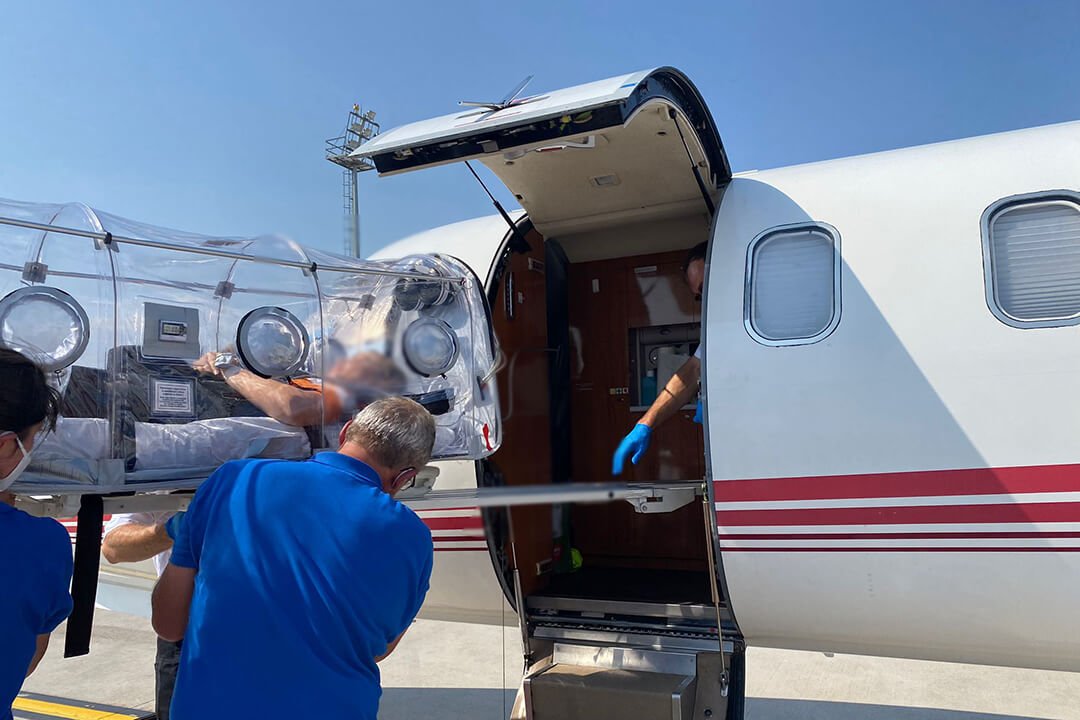Is flying with a fever possible?
Reading Time: 5 minutes
Table of contents
- Is flying with a fever possible?
- What are the risks of flying with a fever?
- When can you fly again after a fever?
- Travelling with a fever: the safety tips everyone should know!
- Can airlines refuse passengers with a fever?
- Travelling with a fever: best in an air ambulance!
- Our innovation: the patient transportation system for Covid-19 infected passengers
- Do you have any additional questions?
- Contact us right away for medical repatriation!
When the flu and cold seasons begin, symptoms like runny noses and fever appear quickly, intensifying the fear of those who are already concerned about the Covid-19 pandemic. The travel industry is one of the many sectors that have been flipped upside down since the Coronavirus hit the earth like a meteor in 2020. Indeed, it has since been significantly and irreversibly altered, with new rules for domestic and international travellers. Taking your temperature in an airport, for example, was not a big deal previously, but what if you have a fever now? Will you be denied boarding after a temperature check? This is why, before arriving at the airport, travellers should learn about fever, how it affects their health, and how it could potentially endanger other passengers.
While flying with a mild fever is possible in most cases, travellers are recommended to bear the following in mind :
- If you have a fever, it is best to avoid flying commercially. It is not recommended to travel with fever exceeding 38°C.
- Flying while sick may aggravate your symptoms.
- Passengers who are deemed unfit to fly may be denied boarding by airlines.
- It is possible to fly in an air ambulance if you have a fever.
- Our patient transportation system is designed to transport patients in isolation, as needed for COVID-19 cases
- Some common risks and complications of flying with fever include weakness, fatigue, lessened mobility and difficulty breathing.
Is flying with a fever possible?
In certain cases, it is possible to fly with a fever. However, it is preferable, if not strongly advised, to avoid boarding a scheduled flight while being feverish.
When you or your child's temperature rises a few degrees above normal, it means your immune system is working to fight off an infection. In most cases, this is a good thing. However, if your fever exceeds 37°C, it should be treated immediately and, if necessary, visit your doctor if the fever does not come down within a few days.
As a result, a good rule of thumb is to avoid flying if you have a fever. A fever is defined as a temperature of 37.7°C or higher in adults and 37.2°C in children (oral or armpit temperature).

What are the risks of flying with a fever?
A fever, in general, makes you lose bodily fluids more quickly. This, combined with the low humidity in the plane cabin might accelerate dehydration. Dehydration exacerbates your symptoms, causing fatigue, headaches, light-headedness, and other discomforts that can be amplified by high altitude.
When it comes to flying with a fever or a feverish child, there are a few things to consider:
Will flying with a fever make you or your child feel worse?
An airplane's cabin is an unusual environment. As stated above, the air tends to be quite dry and contains lower levels of oxygen due to the difference in air pressure as the plane ascends and descends. These physical changes may affect how you or your child feels when flying with a fever.
Will you or your child be miserable?
While flying will not necessarily worsen your fever, it can still make the flight a miserable experience. Flying with a temperature higher than normal, for example, could cause dehydration, acute fatigue, headaches, and dizziness. Having to deal with those symptoms in a crowded, cramped cabin isn't anyone's idea of a fun flight.
Will you or your child get other passengers sick?
Certain illnesses, such as chickenpox, influenza, or fever, are highly contagious, and a passenger with one of these is likely to make others sick.
When can you fly again after a fever?
It is best to fly at least 1 or 2 days after you have recovered from a fever.
Let’s assume that your fever prevents you from flying. When should you rebook your flight? If you decide to change your plans and postpone your trip, you should do so after you have been fever-free for at least 24 to 48 hours.
And, of course, if you have been diagnosed with Covid-19, the rules change. Indeed, most commercial airlines will ask you to postpone your flight for at least 14 days if you test positive for Covid-19. Some may require even a longer period of waiting time following your diagnosis.
Travelling with a fever: the safety tips everyone should know!
If you or your child has a fever and have an upcoming flight, consult your doctor/paediatrician for approval. Once the doctor has given you the all-clear, take the following precautions to make the flight as pleasant as possible for both of you:
- Bring basic medications with you. It is always a good idea to have some on hand just in case.
- Drink plenty of water. This is sound advice for all passengers, regardless of their health condition and age.
- Bring sanitising wipes with you and clean everything you come into contact with: chair arms, seat belt buckles, tray tables and other high-touch surfaces.
- Bring your child's favourite toys, colouring books, games, or cartoons. They may divert his/her attention away from discomfort.
- Bring your own tissues and wipes. They are typically softer and more absorbent than the on-board options.
- Carry extra clothing in case your child gets dirty or vomits.
- Enquire about the nearby healthcare facilities in the UK or in the country you are travelling to. It saves time and stress if you already know where to go if the fever worsens. Make sure to bring your insurance and other medical cards too.
Can airlines refuse passengers with a fever?
Airlines have the right to deny boarding to passengers with medical conditions that could worsen and result in serious consequences during the flight. For example, while having a common cold is not an issue, patients having a contagious disease of a certain severity will not be transported by commercial airliners. Also, they may request medical clearance from their medical department when coming across someone they believe is unfit to fly.
Travellers with flu-like symptoms such as fever, cough, runny nose, congestion, nausea, vomiting, or diarrhoea were already considered contagious long before the Coronavirus became a known threat. And in this day and age dominated by the highly contagious and potentially deadly infectious disease, the first thing that comes to mind when you have a fever is a possible Covid-19 infection. By the way, even if you are not infected with the Coronavirus but are sick with the flu, you can still infect someone up to 2 metres away.
Moreover, while a cold or the flu is common in the autumn and winter, both are difficult to distinguish from a Covid-19 infection without a test. This implies that commercial airlines must go above and beyond to prioritise the health of their passengers and employees.
As a result, while symptoms such as a mild fever, a runny nose, or a tickle in the throat may have previously been dismissed, you can no longer fly commercially unless you certify that you do not have any Covid-19 symptoms, such as a fever of 38°C or higher, shortness of breath or difficulty breathing, a cough, and more. However, as long as you are fever-free, a minor cold or runny nose should not prevent you from travelling.
Travelling with a fever: best in an air ambulance!
Long-distance patient transportation by an ambulance aircraft is the best option for sick or injured passengers. At Medical Repatriation UK, our air ambulances are outfitted with permanent medical equipment that can also be customised to meet the needs of individual patients. During the flight, an experienced medical team is on board to provide the best possible care to the latter in the event of an in-flight emergency.
Patients in need of intensive care, as well as babies and infants, can be transported by our air ambulances, since they are equipped similarly to a flying intensive care unit and have the necessary equipment required for paediatric ambulance flights, namely paediatric incubators or babypods.
Furthermore, in contrast to commercial aircraft, flying under sea-level conditions and adjusting the cabin’s air pressure to pressurise it at ground level is only possible in a chartered air ambulance. Apart from fever and Covid-19, this can be essential for medical repatriation of patients with pathologies such as COPD, anaemia, or recent surgical wounds, but also ear and sinus infections.
Our innovation: the patient transportation system for Covid-19 infected passengers
Patients suffering from severe Covid-19 symptoms must be isolated during transport to avoid infecting others. As a result, our medical aircraft can be outfitted with a modern patient transportation system, which in simple terms, can be described as an isolation shell.

The negative pressure of this device keeps viruses from spreading inside the cabin, and the filtered ventilation ensures that the patient gets enough oxygen. The on-board specialist doctor can perform all of the medical procedures required to stabilise the latter thanks to the various ports. This ensures that he receives the best possible care while also ensuring everyone else's safety. Of course, the medical aircraft is thoroughly disinfected before and after the flight.
Do you have any additional questions?
Many of the most frequently asked questions about long-distance patient transfer to the UK are addressed in our FAQ.
Contact us right away for medical repatriation!
Please contact our 24-hour service at any time if you require additional information or a free non-binding quote. Our friendly and knowledgeable staff can be reached:
- Telephone: +44 (0) 20 3608 0483
- Email: info@medical-repatriation.uk
- Our contact form